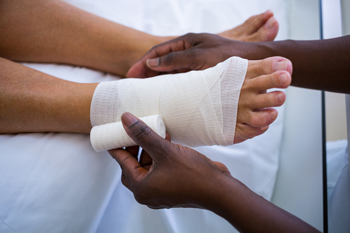Connect With Us
Blog
Items filtered by date: August 2025
Common Foot Problems in Tennis Players

The fast, high-impact nature of tennis places significant strain on the feet. Rapid side-to-side movements, abrupt stops, and quick takeoffs can result in problems such as ligament sprains, overuse injuries, stress fractures, and painful heel or arch conditions. Hard playing surfaces can intensify pressure on the joints, and shoes lacking proper support may leave feet vulnerable. Continuous directional changes also challenge ankle stability, increasing the risk of injury. Choosing tennis footwear designed for cushioning and strong lateral support is an important step in protection. Strengthening and stretching the lower legs and feet can further enhance resilience. Players should watch for early signs of discomfort and rest when needed to prevent long-term issues. If soreness, swelling, or persistent foot pain occurs after playing, it is suggested that you see a podiatrist for a diagnosis and appropriate treatment.
Ankle and foot injuries are common among athletes and in many sports. They can be caused by several problems and may be potentially serious. If you are feeling pain or think you were injured in a sporting event or when exercising, consult with Michele Kraft, DPM from Toes on the Go. Our doctor will assess your condition and provide you with quality foot and ankle treatment.
Common Injuries
The most common injuries that occur in sporting activities include:
- Achilles Tendonitis
- Achilles Tendon Rupture
- Ankle Sprains
- Broken Foot
- Plantar Fasciitis
- Stress Fractures
- Turf Toe
Symptoms
Symptoms vary depending upon the injury and in some cases, there may be no symptoms at all. However, in most cases, some form of symptom is experienced. Pain, aching, burning, bruising, tenderness, tightness or stiffness, sensation loss, difficulty moving, and swelling are the most common symptoms.
Treatment
Just as symptoms vary depending upon the injury, so do treatment options. A common treatment method is known as the RICE method. This method involves rest, applying ice, compression and elevating the afflicted foot or ankle. If the injury appears to be more serious, surgery might be required, such as arthroscopic or reconstructive surgery. Lastly, rehabilitation or therapy might be needed to gain full functionality in the afflicted area. Any discomfort experienced by an athlete must be evaluated by a licensed, reputable medical professional.
If you have any questions, please feel free to contact our office located in Carmel, CA . We offer the newest diagnostic and treatment technologies for all your foot care needs.
Plantar Warts Can Be Treated!
How Wound Care for Feet Has Evolved Over Time

Caring for foot wounds has a surprisingly long history. As far back as 2200 BC, people were using techniques that laid the foundation for today’s wound care. Ancient clay tablets describe washing wounds, applying early forms of dressings, and using bandages to help injuries heal. Early plasters included ingredients like clay, herbs, and even oil, which helped protect wounds and keep bandages from sticking to sensitive skin. In Egypt, healers used honey, grease, and lint to treat wounds. Honey not only kept bacteria at bay but also helped seal injuries from infection. Egyptians even painted wounds green to symbolize life and healing, though this had a practical side too, since the copper in green pigment fought bacteria. Today, foot wound care involves much more advanced materials and techniques, but the basics remain similar. If you have a slow-healing or infected foot wound, it is suggested you visit a podiatrist for appropriate care.
Wound care is an important part in dealing with diabetes. If you have diabetes and a foot wound or would like more information about wound care for diabetics, consult with Michele Kraft, DPM from Toes on the Go. Our doctor will assess your condition and provide you with quality foot and ankle treatment.
What Is Wound Care?
Wound care is the practice of taking proper care of a wound. This can range from the smallest to the largest of wounds. While everyone can benefit from proper wound care, it is much more important for diabetics. Diabetics often suffer from poor blood circulation which causes wounds to heal much slower than they would in a non-diabetic.
What Is the Importance of Wound Care?
While it may not seem apparent with small ulcers on the foot, for diabetics, any size ulcer can become infected. Diabetics often also suffer from neuropathy, or nerve loss. This means they might not even feel when they have an ulcer on their foot. If the wound becomes severely infected, amputation may be necessary. Therefore, it is of the upmost importance to properly care for any and all foot wounds.
How to Care for Wounds
The best way to care for foot wounds is to prevent them. For diabetics, this means daily inspections of the feet for any signs of abnormalities or ulcers. It is also recommended to see a podiatrist several times a year for a foot inspection. If you do have an ulcer, run the wound under water to clear dirt from the wound; then apply antibiotic ointment to the wound and cover with a bandage. Bandages should be changed daily and keeping pressure off the wound is smart. It is advised to see a podiatrist, who can keep an eye on it.
If you have any questions, please feel free to contact our office located in Carmel, CA . We offer the newest diagnostic and treatment technologies for all your foot care needs.

